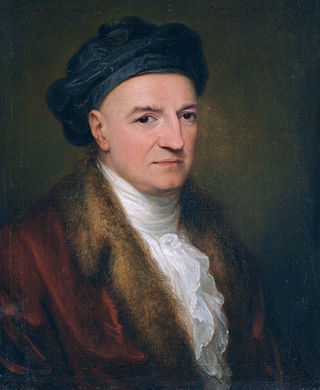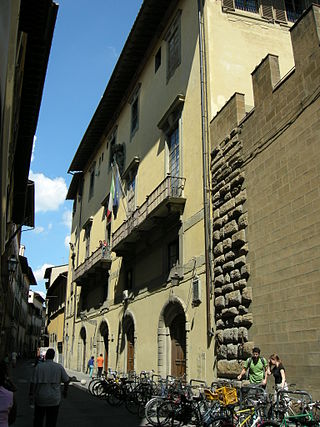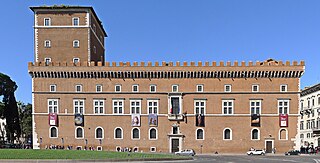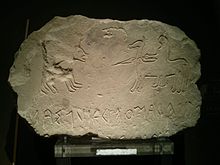
Luca Giordano was an Italian late-Baroque painter and printmaker in etching. Fluent and decorative, he worked successfully in Naples, Rome, Florence, and Venice, before spending a decade in Spain.

Fano[ˈfaːno] is a town and comune of the province of Pesaro and Urbino in the Marche region of Italy. It is a beach resort 12 kilometres southeast of Pesaro, located where the Via Flaminia reaches the Adriatic Sea. It is the third city in the region by population after Ancona and Pesaro.

Pesaro is a city and comune (municipality) in the Italian region of Marche, capital of the Province of Pesaro e Urbino, on the Adriatic Sea. According to the 2011 census, its population was 95,011, making it the second most populous city in the Marche, after Ancona. Pesaro was dubbed the "Cycling City" by the Italian environmentalist association Legambiente in recognition of its extensive network of bicycle paths and promotion of cycling. It is also known as "City of Music", for it is the birthplace of the composer Gioacchino Rossini. In 2015 the Italian Government applied for Pesaro to be declared a "Creative City" in UNESCO's World Heritage Sites. In 2017 Pesaro received the European City of Sport award together with Aosta, Cagliari and Vicenza.

The Capitoline Museums are a group of art and archaeological museums in Piazza del Campidoglio, on top of the Capitoline Hill in Rome, Italy. The historic seats of the museums are Palazzo dei Conservatori and Palazzo Nuovo, facing on the central trapezoidal piazza in a plan conceived by Michelangelo in 1536 and executed over a period of more than 400 years.

The Accademia di San Luca is an Italian academy of artists in Rome. The establishment of the Accademia de i Pittori e Scultori di Roma was approved by papal brief in 1577, and in 1593 Federico Zuccari became its first principe or director; the statutes were ratified in 1607. Other founders included Girolamo Muziano and Pietro Olivieri. The Academy was named for Luke the Evangelist, the patron saint of painters.

The National Roman Museum is a museum, with several branches in separate buildings throughout the city of Rome, Italy. It shows exhibits from the pre- and early history of Rome, with a focus on archaeological findings from the period of Ancient Rome.

The Museo Civico d'Arte Antica is an art museum located in the Palazzo Madama in Turin, Italy. It has a renowned collection of paintings from the medieval, Renaissance and Baroque periods. It reopened in 2006 after several years of restorations.

Giovanni Volpato (1735–1803) was an Italian engraver. He was also an excavator, dealer in antiquities and manufacturer of biscuit porcelain figurines.

The National Archaeological Museum of Florence is an archaeological museum in Florence, Italy. It is located at 1 piazza Santissima Annunziata, in the Palazzo della Crocetta.

Stefano Borgia was an Italian Cardinal, theologian, antiquarian, and historian.

The Biblioteca Riccardiana is an Italian public library under the aegis of the Ministry of Culture, located inside the Palazzo Medici Riccardi at 10 Via de’ Ginori in Florence, in the neighborhood comprising the Mercato Centrale and the Basilica di San Lorenzo. Its main feature is preserving books collected by members of the Riccardi family and making them available in the very same rooms that were originally dedicated to that purpose. So, still today the library boasts the magnificent bookshelves, neatly carved and gilded, that create the atmosphere of a late-seventeenth-century patrician library, whose main features have all been kept intact.

The Biblioteca Palatina or Palatina Library was established in 1761 in the city of Parma by Philip Bourbon, Duke of Parma. It is one of the cultural institutions located in the Palazzo della Pilotta complex in the center of Parma. The Palatina Library was named after Apollus Palatinus.

The Conservatorio Statale di Musica "Gioachino Rossini" is a music conservatory in Pesaro, Italy. Founded in 1869 with a legacy from the composer Gioachino Rossini, the conservatory officially opened in 1882 with 67 students and was then known as the Liceo musicale Rossini. By 2010 it had an enrollment of approximately 850 students studying for higher diplomas in singing, instrumental performance, composition, musicology, choral conducting, jazz or electronic music. The conservatory also trains music teachers for secondary schools and holds regular master classes. Its seat is the 18th century Palazzo Olivieri–Machirelli on the Piazza Oliveri in Pesaro. Amongst its past Directors are the composers Carlo Pedrotti, Pietro Mascagni, Riccardo Zandonai and Franco Alfano. Mascagni's opera Zanetto had its world premiere at the conservatory in 1896.
Annibale degli Abati Olivieri was an Italian archaeologist, numismatist and librarian, considered the founder of the Biblioteca Oliveriana, Pesaro. An aristocrat without heirs, he was the author of works of archeology and numismatics. He also discovered the site of a Roman sacred grove, the Lucus Pisaurensis at his property on Collina di Calibano in the countryside of Pesaro, at which he unearthed the 13 Votive Stones of Pesaro.
The Ancient Votive Stones of Pesaro are 13 sandstone rocks that were unearthed in 1737 in a Pesaro, Italy farm field owned by Patrician Annibale degli Abati Olivieri. Oliverio dug up the stones at the site of his newly discovered Lucus Pisaurensis Sacred Grove on his property at Il Pignocco in Pesaro.
Lucus Pisaurensis is a sacred grove or lucus of ancient Pisaureum, modern Pesaro in Italy. It is just outside the coastal comune of Pesaro, between the Colle della Salute and the Collina in Santa Veneranda. It is in the Pesaro e Urbino Province of Marche, a pre-Imperium Romanum region of the Sabines and Latins peoples.

The Museo Nazionale del Palazzo di Venezia is a state museum in Rome (Italy), housed in the palace of the same name together with the important Library of Archaeology and Art History.

The Civic Museum of Mirandola is a museum housed in the castle of the Pico in Mirandola, in the province of Modena, Italy, dedicated to the archaeology of the territory, religious commissions, ancient furnishings and paintings, coins and medals of the ancient mint of Mirandola. The museum is also enriched by maps from the 16th to the 20th century, various items from the ancient Mount of Piety of the Franciscan friars and a collection of military relics.


















